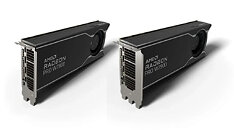
AMD's Answer to AI Advancement: ROCm 7.0 Is Here
In August, AMD will release ROCm 7, its open computing platform for high‑performance computing, machine learning, and scientific applications. This version will support a range of hardware, from Ryzen AI-equipped laptops to Radeon AI Pro desktop cards and server-grade Instinct GPUs, which have just received an update. Before the end of 2025, ROCm 7 will be integrated directly into Linux and Windows, allowing for a seamless installation process with just a few clicks. AMD isn't planning to update ROCm once every few months, either. Instead, developers will receive day-zero fixes and a major update every two weeks, complete with performance enhancements and new features. Additionally, a dedicated Dev Cloud will provide everyone with instant access to the latest AMD hardware for testing and experimentation.
Early benchmarks are encouraging. On one test, an Instinct MI300X running ROCm 7 reached roughly three times the speed recorded with the original ROCm 6 release. Of course, your mileage will vary depending on model choice, quantization, and other factors. This shift follows comments from AMD's Senior Vice President and Chief Software Officer, Andrej Zdravkovic, whom we interviewed last September. He emphasized ROCm's open-source design and the utility of HIPIFY, a tool that converts CUDA code to run on ROCm. This will enable a full-scale ROCm transition, now accelerated by a 3x performance uplift simply by updating the software version. If ROCm 7 lives up to its promise, AMD could finally unlock the potential of its hardware across devices, both big and small, and provide NVIDIA with good competition in the coming years.
Early benchmarks are encouraging. On one test, an Instinct MI300X running ROCm 7 reached roughly three times the speed recorded with the original ROCm 6 release. Of course, your mileage will vary depending on model choice, quantization, and other factors. This shift follows comments from AMD's Senior Vice President and Chief Software Officer, Andrej Zdravkovic, whom we interviewed last September. He emphasized ROCm's open-source design and the utility of HIPIFY, a tool that converts CUDA code to run on ROCm. This will enable a full-scale ROCm transition, now accelerated by a 3x performance uplift simply by updating the software version. If ROCm 7 lives up to its promise, AMD could finally unlock the potential of its hardware across devices, both big and small, and provide NVIDIA with good competition in the coming years.





















































